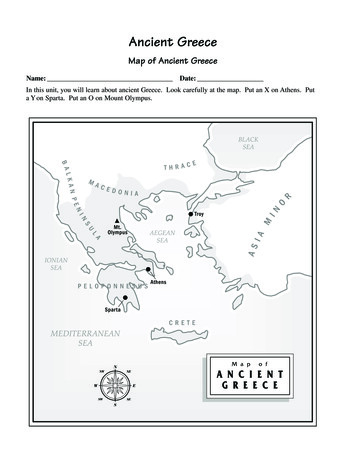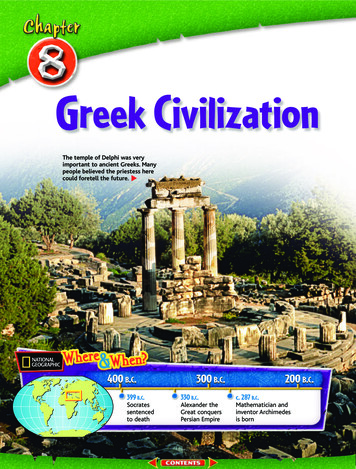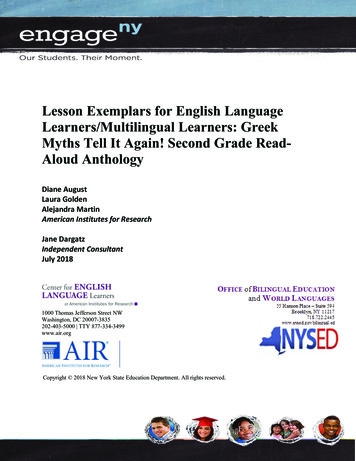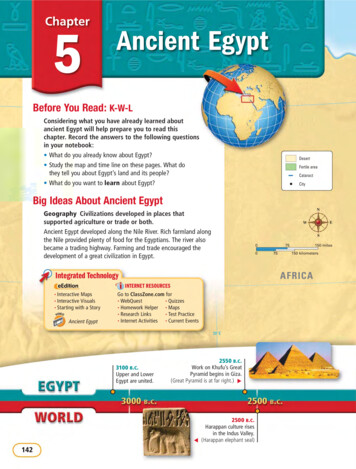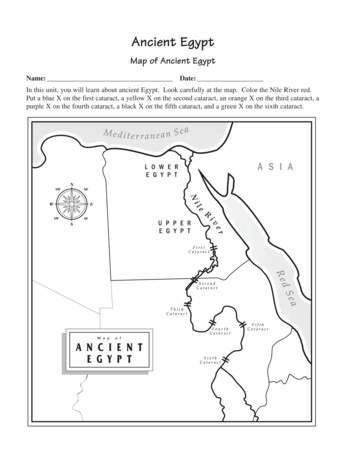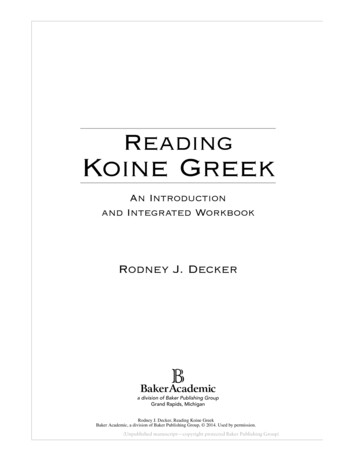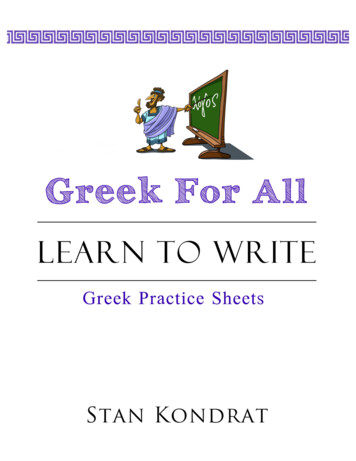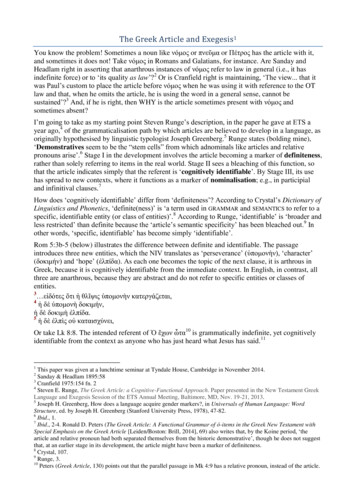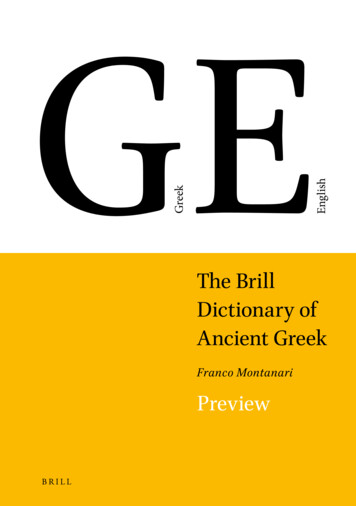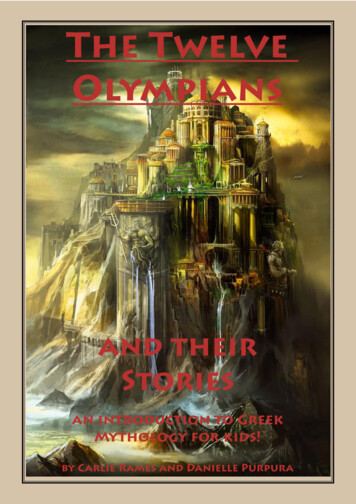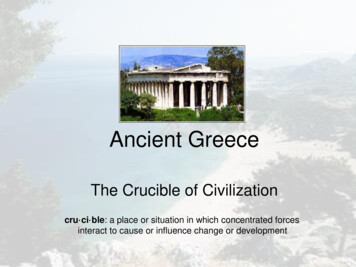
Transcription
Ancient GreeceThe Crucible of Civilizationcru·ci·ble: a place or situation in which concentrated forcesinteract to cause or influence change or development
Geography
Located in southeastern Europe, Greece is defined by a series of mountains andsurrounded on all sides except the north by water.
Ancient Greek View of the World
The Mediterranean Seamoderates Greece'sclimate, cooling the air insummer and providingwarmth in the wintermonths. Summers aregenerally hot and dry.Winters are moderate andrainy in coastal regions andcold and snowy inmountainous areas.
Geographic factors played an important role in Greek history.
Numerous MOUNTAIN RANGES, which crisscross thepeninsula, hampered internal communications and led tothe development of independent city-states.Numerous ISLANDS and the indented coastlines of theGreek peninsula and of Asia Minor stimulated a seagoingtrade.The ROCKY SOIL and limited natural resourcesencouraged the Greeks to establish colonies abroad.
History
GREEK HISTORY: AN OVERVIEWGreek CIVILIZATION started around 2000 B.C. By 1600 B.C., the Greekpeople had built fortified cities in the major valleys and many people wereeducated. Greece then had several wars, including the Trojan War around1200 B.C., which threw them into what is known as the Dark Age.During the DARK AGE, knowledge of writing was lost and most peoplelived in isolated villages. The Dark Age ended in about 800 B.C when theGreeks started to write again with an alphabet based on that of thePhoenicians.During that time, many city-states emerged and struggled with each otherfor power for hundreds of years after that. In 480 B.C., the GreeksUNITED to defeat the invading Persians, but the alliance didn’t last long.Around 477 B.C., two city-states, ATHENS AND SPARTA, became thedominant powers in that region and constantly fought each other forpower. Greece had its GOLDEN AGE in Athens around 477 - 431 B.C.
In 334 B.C., ALEXANDER THE GREAT, leader of the country ofMacedonia to the north, conquered the Greeks and started whatis called the HELLENISTIC AGE. Greece unwillingly remainedunder Macedonian control until the Romans conquered bothMacedonia and Greece around 140 B.C.The ROMANS then spread the knowledge of the ancient Greekphilosophers throughout their empire. The Roman Empire lastedas a unified empire until 395 A.D. when it was split into theeastern and western empires.Greece became part of the eastern or BYZANTINE EMPIRE andGreek literature became the basis for learning in Byzantineinstitutions, especially in Constantinople, its capital. WhenConstantinople was destroyed by the Turks in 1453 A.D., theGreek literature stored there spread to the rest of Europe andhelped start the RENAISSANCE.
Agriculture
Only 20-30% of ancient Greece’s land was arable. The most importantcrops were olives, grapes, and barley.
ECONOMIC CONDITIONS were those of a simple,self-sufficient agricultural system.CROPS: The Greeks used OLIVES for eating andto make olive oil, used for cooking and as a lubricant.They made wine from GRAPES. The common drink of everyone was amixture of wine and water. Even children drank it. Dionysius, themythological god of the vine, oversaw and blessed everything having todo with growing grapes and making wine.BARLEY was used to make bread and was a staplepart of the Greek diet. Demeter was the mythologicalgoddess of grain.LIVESTOCK: The ancient Greeks kept CHICKENS,PIGS, SHEEP, and GOATS (for milk and meat).They would only eat the meat of animals who hadbeen sacrificed in the name of a god.Generally, they did not eat a lot of meat, but instead dependedupon FISH and LEGUMES (beans, chickpeas, and lentils) for protein.
Government
The POLIS (city-state) consisted of a city and its surrounding plains andvalleys. The nucleus of the polis was the elevated, fortified site called theACROPOLIS where people could take refuge from attack. With the revivalof commerce, a TRADING CENTER developed below the acropolis
Four major TYPES OF GOVERNMENT evolved in ancientGreece: Monarchy (rule of a king) limited by an aristocratic counciland a popular assembly. Oligarchy (rule of the few) arising when the aristocraticcouncil ousted the king and abolished the assembly. Tyranny (rule by one who ruled without legal authority) ridingto power on the discontent of the lower classes. Democracy (rule of the people), the outstanding politicalachievement of the Greeks.
By the middle of the 8th century B.C., the nobles, whoresented the power of the tribal king, had taken over thegovernment, ushering in the AGE OF OLIGARCHY: Nobles ruthlessly acquired the best land.Many commoners were reduced to virtualserfdom.Other commoners were forced to seek a living onrocky, barren soil.
Greece and her colonies (red) in the mid-sixth century B.C. Also shown are thetwo main rivals of Greece, the Phoenicians (purple) and the Etruscans (yellow).In time, COLONIZATION ameliorated Greece's economic and social problems. By 600 B.C., the use of coined money had created the beginnings of amiddle class. The Greek home states focused on the production of specialized wares(vases, metal goods, textiles, olive oil, wine) for export.
The continuing land hunger of the peasants contributed to aPOLITICAL REVOLUTION. After 650 B.C., TYRANTS arose in many Greek citystates and, supported by the peasantry and risingmerchant class, seized the reigns of government fromthe nobility. Tyrants redistributed land to the peasants and bypromoting further colonization, trade, and industry,accelerated the rise of the mercantile class andcompleted the ECONOMIC REVOLUTION.
Athens to 500 B.C.In 594 B.C, when Athenian nobles realized their failure to reform wouldresult in a tyrant, they agreed to the policy of compromise advocated bythe liberal aristocrat SOLON. Inspired by the new ideals of moderationand justice, Solon instituted MODERATE REFORMS: Provided a new start for the lower classes by CANCELING DEBTS. Sought FULL EMPLOYMENT by stimulating trade and industry andrequiring fathers to teach their sons a trade Granted common people POLITICAL RIGHTS but not equality.
Unfortunately, Solon's moderate reforms satisfied neither party. After aperiod of civil strife, PISISTRATUS, a military hero and champion of thecommoners, took over as tyrant. Solved the economic problem by BANISHING MANY NOBLES, whoselands he distributed among the poor, and by promoting commerce andindustry. Supported PUBLIC WORKS and the PATRONAGE OF THE ARTS -starting Athens on the path to cultural leadership in Greece.
CLEISTHENES temporarily seized power in 508 B.C. and put throughconstitutional reforms that destroyed the remaining power of the nobility. Created TEN NEW TRIBES, embracing citizens of all classes and districts. Gave the popular ASSEMBLY the RIGHT TO INITIATE LEGISLATION. Gave the new and democratic COUNCIL OF FIVE HUNDRED, SELECTEDBY LOT from the ten tribes the power to advise the assembly and supervisethe administrative actions of the archons. Started the institution of OSTRACISM (an annual referendum) in which aquorum of 6,000 citizens could vote to exile for ten years any individualthought to be a threat to Athenian democracy.Go to film clips about Cleisthenes
During the GOLDEN AGE of Greece (461-429 B.C.), the great statesmanPERICLES guided Athenian policy. Power resided in a board of TEN ELECTED GENERALS.To insure that the POOR COULD PARTICIPATE IN GOVERNMENT,Athens paid jurors (a panel of 6,000 citizens chosen annually by lot) andmembers of the Council.Although DEMOCRACY was an outstanding achievement,it is important to keep in mind that the majority of theinhabitants of Athens were not recognized citizens. WOMEN, SLAVES, and RESIDENT ALIENSwere DENIED CITIZENSHIP.These groups had no standing in the law courts.(If a woman sought the protection of the law, shehad to ask a citizen to plead for her in court.)
Sparta to 500 B.C.The city-state of Sparta expanded by conquering and enslaving itsneighbors. To guard against revolts by the state slaves (helots), whoworked the land, Sparta transformed itself into a militaristicTOTALITARIAN STATE. For the small minority of ruling Spartans, it was a democracy.For the masses, it was an oligarchy (rule by the few).
The state enforced ABSOLUTE SUBORDINATION of theindividual to its will. Every Spartan was first of all a solider. Sickly infants were left to die on lonely mountaintops. Boys were taken from their families at age 7 to live under rigorousmilitary discipline. Girls were trained to be the mothers of warrior sons. Spartan women bid the men farewell by saying: "Come back withyour shield or on it."
Sparta remained BACKWARD culturally and economically.Trade and travel were prohibited for fear that alien ideas woulddisturb the status quo.A SELF-IMPOSED ISOLATION resulted in:– Intellectual stagnation– Rigid social conformity– Military regimentation
To insure that its helots would remain uncontaminated by democratic ideas,Sparta formed the SPARTAN LEAGUE of oligarchic states. When thePersians conquered Lydia in 547 B.C., they also annexed Ionia.In 499 B.C., the Ionian cities revolted, established democratic regimes, andappealed to the Athenians to help.The BATTLE OF MARATHON in 490 B.C. was a decisive victory for theAthenian army, which was half the size of the Persians. (6400 Persians diedas opposed to 192 Athenians.)Ten years later, in the BAY OF SALAMIS, the Greek fleet (largely Athenian)turned the tide of victory and forced the Persians to retreat.
In 478 B.C., Athens invited the city-states bordering on the Aegean to form adefensive alliance called the DELIAN LEAGUE.To maintain a 200 ship navy that would police the seas, each state wasassessed ships or money in proportion to its wealth.By 468 B.C., after the Ionian cities had been liberated and the Persian fleetdestroyed, various League members thought it unnecessary to continue theconfederacy.Motivated by fear of the Persians and by the need to protect free-trade, theAthenians suppressed all attempt to secede and created an informalEMPIRE.By aiding in the suppression of local aristocratic factions within its subjectstates, Athens emerged as the leader of a union of democratic states.However, its HUBRIS (excessive pride) proved to be its undoing.
To many Greeks, especially the oligarchic SPARTAN LEAGUE and thearistocratic factions within the Athenian empire, ATHENS WAS A TYRANTCITY and an enslaver of Greek liberties.In 431 B.C., the PELOPONNESIAN WAR broke out between the SpartanLeague and the Athenian empire.COMMERCIAL RIVALRY between Athens and Sparta's ally Corinth was animportant factor.Real cause: SPARTAN FEAR of Athens' growth of power.STRENGTHS:Sparta's army had the ability to besiege Athens and lay waste to its fields.Athens' unrivaled navy could import foodstuffs and harass its enemies' costs.WEAKNESSES:In 2nd year of war, a plague killed a third of the Athenian population, includingPericles.Leadership of the Athenian government passed to demagogues.
The Peloponnesian War (431-404 B.C.)Nearly all of Greece was polarized between two alliances.
A compromise peace was reached in 421 B.C. During the succeedingperiod, ATHENIAN IMPERIALISM manifested itself in its worst form.In 416 B.C., an expedition embarked for MELOS, A NEUTRAL AEGEANISLAND, to force it to join the Athenian empire.Acting on the premise that "might makes right," the Athenians PUT ALLMELIANS OF MILITARY AGE TO DEATH and SOLD THE WOMEN ANDCHILDREN INTO SLAVERY.This exhibition of HUBRIS was their downfall.In 404 B.C., ATHENS CAPITULATED after its last fleet was destroyed by aSpartan fleet built with money received from Persia in exchange for theGreek cities in Ionian.The once great city of Athens was stripped of its possessions anddemilitarized.
Architecture
The Parthenon Today
The Acropolis of um of HerodesAtticus (Roman)King’sShrineStoa ofEumenesTheater ofDionysiusSanctuary ofAsclepius
Religion
The Greeks were POLYTHEISTIC and did not all worship the same gods.Some small villages worshiped the main gods and their own village gods.There were hundreds of Greek gods (perhaps around 1,000). Some of themost famous gods were Zeus, Hera, Apollo, Artemis, Poseidon,Aphrodite, Athena, Demeter, Hermes, Ares, and Hades.ZEUS surpassed all other gods in spirit, wisdom and justice and his wifeHERA was the queen of the gods.
SACRIFICES to please the gods were a major part of every Greek'sreligion. Most gods preferred an animal sacrifice -- generally aDOMESTICATED ANIMAL like a chicken, goat or cow.When an animal was sacrificed, it was burned on top of an altar. Afterit was fully cooked, it had to be EATEN ON THE SPOT -- usuallybefore nightfall. These sacrifices were the property of the god, andhad to be eaten in his presence.This was especially important because the ancient Greeks believedthat the god's spirit was within the animal sacrificed, and by eating theanimal, the worshippers CONSUMED HIS POWER. In this way, theystrengthened the connection between man and god.
Dating back to 1200 BC, the Oracle of Delphi was the most important shrine inall Greece. Built around a sacred spring, Delphi was considered to be theomphalos - the center (literally navel) of the world.People came from all over Greece and beyond to have their questions about thefuture answered by the Pythia, the priestess of Apollo. And her answers, usuallycryptic, could determine the course of everything from when a farmer plantedhis seedlings, to when an empire declared war.
Visit the Parthenon as It was 2000 Years Ago
Daily Life
The daily diet included CEREALS (like wheat and barley), GRAPES, andOLIVES -- commonly called the MEDITERRANEAN TRIAD.The Greeks typically made grapes into WINE and olives into OLIVE OIL, so theywould keep without refrigeration. Grains and cereals were commonly used forBREAD and PORRIDGE.Diets were supplemented with VEGETABLES and HERBS from kitchen gardensas well as BERRIES, and MUSHROOMS. The poor usually ate FISH, whileoysters, sea urchins, octopus, and eels were considered DELICACIES and onlyeaten by the wealthy.
BREAD in ancient Greece was a very important part of the daily diet. At first allbreads were prepared in the embers of a fire. Eventually the Greeks developed abread OVEN that is similar in function to the ovens we use today. Because theyrequired less wood or charcoal (which was expensive), these ovens made breadAVAILABLE TO ALMOST EVERYONE.The most common type of bread in Greece was called MAZA which was a flatbread made from barley flour. Most meals consisted of maza and some sort ofaccompaniment to the bread called OPSON. This might be vegetables, fish,olives, onions, garlic, fruit, and on a rare occasion, meat.
MEN did most of the hard,muscle power jobs such asPLOWING AND REAPING.The WOMEN SOWED SEED,WEEDED THE FIELDS andTENDED THE HOUSEHOLD andCHILDREN. Women might alsogrow SMALL GARDENS aroundthe house with vegetables andbeans. Women might also bringin extra income for the farm witha CRAFT TRADE such asweaving that they might sell at amarket.
Farmers had to give a SMALL PORTION of their crops to the godsas a SACRIFICE and to the city-state for TAXES. This left thefarmers with just enough to feed their families.The land was divided very precisely. Each household in a poliswas given a plot of land. This plot would be handed down to thechildren. If the farmer could not pay his land taxes; a WEALTHIERLAND OWNER COULD TAKE IT and pay the debt for thefarmer. Many aristocrats built their wealth this way.
GREEK WOMEN: Greek women had very LITTLE FREEDOM outside thehome. They could attend weddings, funerals, some religious festivals, andcould visit female neighbors for brief periods of time.In their homes, Greek women were in charge. Their job was to RUN THEHOUSE AND TO BEAR CHILDREN.Most Greek women themselves as most households had slaves. DID NOTDO HOUSEWORKFEMALE SLAVES cooked, cleaned, and worked in the fields.MALE SLAVES watched the door to make sure no one came in when theman of the house was away, except for female neighbors, and acted astutors to the young male childrenWives and daughters were NOT ALLOWED TO WATCH THE OLYMPICGAMES as the participants in the games did not wear clothes.
GREEK HOUSING: Citizens wanted tolive within the CITY because it was theCENTER OF CIVIC LIFE. They builtprivate houses along NARROWSTREETS; crowded up against oneanotherUnlike the luxurious public buildings,houses were built in a simple manner.They were made up of TWO OR THREEROOMS, around an open airCOURTYARD and were made ofSTONE, WOOD, OR CLAY BRICKS.LARGER HOMES might also have aKITCHEN, a ROOM FOR BATHING, aMEN’S DINING ROOM, and perhaps aWOMAN’S SITTING AREA.MEN spent most of the time in the Agoraor abroad - only returning home to EATAND SLEEP.WOMEN were SEGREGATED in theirown quarters - on the ground floor orsecond level of a two storey home
Typical Day of a Greek Housewife .7:05 Rises7:08 Eats small piece of bread soaked in wine. Is still hungry, but must becareful about her figure7:09 Pecks husband on cheek and sends him off to the agora. Sighs. Looksat the four bare (slightly tinted) walls. Rarely allowed out of the house, sheprepares for another day at home.7:15 Summon hand maiden to cool her with huge peacock feather.8:30 All dressed up with no place to go, she wanders into the kitchen, eyesa piece of honey cake. Resists.9:27 Hears argument between two servants, rushes out to mediate.11:15 Wanders into the courtyard near flowerbed where slave girls arespinning and giggling. Asks to join them. Is reminded this is improperbehavior - they suggest she ready herself for lunch.12:15 Husband arrives, chiding her about the foolishness of make-up.Pretends to agree. Husband leaves at 12:223:00 Instructs daughter on her duties of being a wife.8:05 Husband and wife sit down at low table to dinner; bread, oil, wine, afew figs, small portion of fish (only 320 calories) and beans. She hearsabout his day. He tells her she should not bother about the affairs of men.Pretends to agree. She is too hungry to argue.10:10 Falls asleep. Does not dream of tomorrowExcerpt from: Lynn, Schnurnberger. Let There Be Clothes.
GREEK CLOTHING: Greek clothingwas very SIMPLE.Men and women wore LINEN IN THESUMMER and WOOL IN THEWINTER. Women were expected tobe decently coveredThe ancient Greeks could buy clothand clothes in the AGORA, themarketplace, but that was expensive.Most families MADE THEIR OWNclothes, which were SIMPLE TUNICSAND WARM CLOAKS, dyed a brightcolor or bleached white.Clothes were MADE BY THEMOTHER, her daughters, and femaleslaves.
According to tradition the first OLYMPICS took place in 776 BC. Theybecame a central aspect of Greek culture and in many ways were themost important factor uniting the Greeks, except for their language andmythology.
part of the Greek diet. Demeter was the mythological goddess of grain. LIVESTOCK: The ancient Greeks kept CHICKENS, PIGS, SHEEP, and GOATS (for milk and meat). They would only eat the meat of animals who had been sacrificed in the name of a god. Generally, they did not eat a lot of meat, but instead depended
